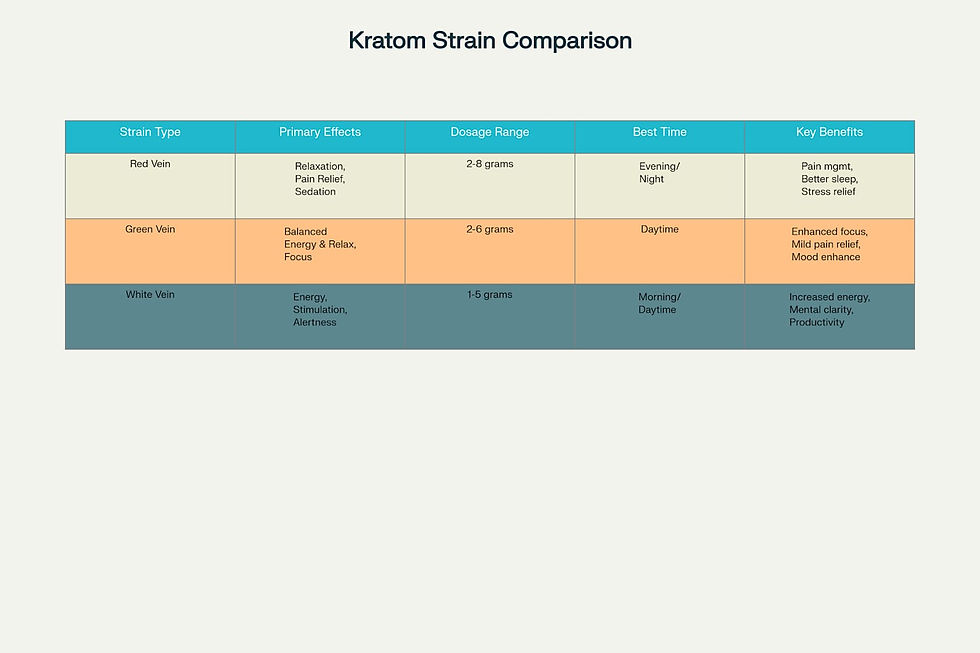Understanding Kratom: A Comprehensive Guide for New users
- Swan Htet
- Jun 18
- 4 min read
Updated: Jul 7

Kratom has emerged as one of the most debated botanical substances in recent years, with millions of users worldwide reporting various benefits while health authorities express growing concerns about its safety. This comprehensive guide explores what kratom is, how it works, its various forms and effects, and the complex legal and safety landscape surrounding this Southeast Asian plant.
What Is Kratom?
Kratom (scientifically known as Mitragyna speciosa) is a tropical evergreen tree belonging to the coffee family (Rubiaceae) that is indigenous to Southeast Asia, including Thailand, Malaysia, Indonesia, Myanmar, Cambodia, and Papua New Guinea. The tree can grow up to 15 meters (50 feet) tall and produces glossy, dark green leaves that have been used in traditional medicine for centuries[3].
The leaves of the kratom tree contain over 40 different alkaloids, with the two primary psychoactive compounds being mitragynine and 7-hydroxymitragynine. These alkaloids interact with opioid receptors in the brain, producing effects that can range from stimulating at low doses to sedating at higher doses.

Historical and Traditional Use
For centuries, people in Southeast Asia have used kratom leaves in various ways as part of their traditional medicine practices. Farmers and laborers would commonly chew fresh kratom leaves or brew them into tea to combat fatigue, increase energy and stamina during long working hours, and manage pain. The practice was so ingrained in the culture that kratom was known by different names across the region, including "ketum," "ithang," and "thom"[5].
Historically, kratom also served as an opium substitute and was used to help people manage withdrawal symptoms from opium addiction during the 19th century when opium dependency was a significant problem in many Southeast Asian countries[2].
Chemical Composition and Alkaloids
Kratom's effects are primarily attributed to its rich alkaloid profile, with researchers having identified over 54 different compounds and more than 25 alkaloids in the plant[2]. The concentration and ratio of these alkaloids can vary significantly based on factors such as:
· Geographic origin of the plant
· Age and maturity of the leaves
· Season of harvest
· Post-harvest processing methods
· Environmental conditions[6]

The primary alkaloids include:
· Mitragynine: The most abundant alkaloid, comprising 60-70% of total alkaloids in Thai varieties[7]. It acts as a partial agonist at μ-opioid receptors and is responsible for many of kratom's pain-relieving and mood-enhancing effects[8][7].
· 7-Hydroxymitragynine: Though present in smaller amounts (typically 2-5% of total alkaloids), this compound is significantly more potent than mitragynine and contributes to kratom's more pronounced opioid-like effects[2][7].
· Speciofoline: Found in variable concentrations, this alkaloid appears to have minimal psychoactive effects and does not significantly bind to opioid receptors[8].
· Paynantheine: Comprises 8-15% of total alkaloids and is associated with muscle relaxation and smooth muscle effects[9].
Kratom Strains and Varieties
Kratom is commonly categorized by the color of the central vein in the leaves, which changes as the plant matures. Each strain is associated with different effects profiles, though individual responses can vary significantly[10][11].

Red Vein Kratom
Red vein kratom comes from the most mature leaves and is typically associated with:
· Primary effects: Relaxation, pain relief, sedation
· Common uses: Evening use, sleep support, chronic pain management
· Popular strains: Red Maeng Da, Red Borneo, Red Bali
· Typical dosage: 2-8 grams
Green Vein Kratom
Green vein kratom represents a middle ground between red and white strains:
· Primary effects: Balanced energy and relaxation, enhanced focus
· Common uses: Daytime use, mood enhancement, mild pain relief
· Popular strains: Green Maeng Da, Green Bali
· Typical dosage: 2-6 grams
White Vein Kratom
White vein kratom comes from young leaves and is known for:
· Primary effects: Energy, stimulation, mental clarity
· Common uses: Morning use, productivity enhancement, alertness
· Popular strains: White Maeng Da, White Borneo, White Thai
· Typical dosage: 1-5 grams

Forms and Methods of Consumption
Kratom is available in various forms to suit different preferences and needs:
Traditional Forms
· Fresh leaves: Chewed directly or brewed into tea
· Dried leaves: Ground into powder or brewed as tea
· Kratom tea: Traditional preparation method in Southeast Asia

Modern Commercial Forms
· Powder: The most common form, made from dried and ground leaves
· Capsules: Pre-measured doses in gelatin or vegetarian capsules
· Extracts: Concentrated forms with higher alkaloid content
· Tinctures: Liquid extracts for sublingual use

Kratom stands as a remarkable botanical that has served Southeast Asian communities for generations, offering a natural alternative for those seeking balance in their daily lives1. As the global understanding of this traditional plant continues to evolve, the importance of quality, heritage, and craftsmanship becomes increasingly evident. The future of kratom lies not just in its therapeutic potential but in how it's cultivated, processed, and presented to consumers who deserve nothing less than excellence. When kratom is produced with meticulous attention to detail—from the careful selection of mature leaves to ultra-fine milling techniques that preserve the plant's natural alkaloid profile—the difference is unmistakable23. This commitment to quality ensures that users experience kratom as nature intended, with consistent potency and purity that honors the plant's traditional roots




Comments